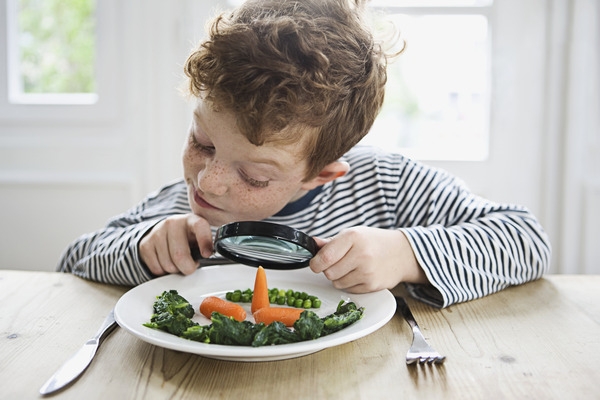If, like me, you have fussy eaters or kids that always gravitate towards the sugary, fried or white stuff, you may be relieved to hear this is an incredibly common and normal part of childhood development. In fact, according to dietitian and nutritionist Lauren Atkins, “It’s part of their exploration of their requirements of food, and a way that children assert their independence and autonomy as little human beings.”
“It’s a very important element of their learning to listen intuitively to their body and their body’s cues,” she says.
As a child’s appetite is also known to fluctuate significantly, don’t be frustrated if your child may have eaten a whole plate of food last week and barely touched it this week. Recognising and responding to their body’s cues may be misread as being fussy, but it could be your child responding innately to their appetite which goes up and down as they grow.
Short periods of fussiness may also be due to tiredness, illness or big emotions, says dietitian Annabel Flynn. “You may feel less concerned about your child’s intake if you look at it over a week instead of on a daily basis,” she suggests.
And even though your kid’s refusal to eat their dinner might drive you up the wall, just remember: healthy children won’t starve themselves. There are, however, some things you can do to encourage your children to be a bit more adventurous with food.
10 ideas for budding foodies
Textures matter
Begin offering foods with a variety of textures (mashed, pureed, chopped etc.) from an early age. Early exposure to different textures can make a big difference later on.
Patience is a virtue
When it comes to getting your kids to discover new flavours, persistence and patience are key. Research has shown new foods may need to be offered at least 10 times before a child will be willing to even try it. So, don’t give up on the first go.
Start small
“Start with just a small amount of food on their plate so as not to overwhelm them,” advises Flynn. Portions that are too big may cause young children to refuse everything.
Say no to bribes
Avoid bribing your child with ‘sometimes foods’ or creating pressure to eat. “This can lead to more food refusal and place preference on less nutritious foods,” says Flynn.
Lead by example
“Sit together for meals whenever possible and model your enjoyment of eating nutritious foods”, says Flynn. “This can help develop healthy habits that continue throughout childhood and into adult life.”
Be considerate but not cater
It can be tempting to cook food you know your fussy eater will actually eat, but providing different options for adults and children, or even between children, can sometimes encourage fussy eaters. When you do serve your child a new food or something they haven’t liked before, Atkins encourages parents to “be considerate but not a caterer.”
Serve something familiar, too
Atkins suggests offering new foods alongside a food your child is comfortable with. That way, your child will look at their plate and feel reassured there is something they can eat and they won’t go hungry.
Get the kids involved
Include the kids in meal planning, grocery shopping and meal/snack prep as frequently as you can. Let them be a part of the process. Part of that means learning to listen to them when they tell you what they like and what they don’t.
“Babies and young children are actually far better at responding to their hunger cues than we are as adults,” says Atkins. “So, we could probably learn a little bit from them, rather than the other way around.”
Resist snacks
Try not to fill your child up with drinks or snacks before dinner time. This is one I’m guilty of. If you can, give them nothing but water to eat or drink for at least one hour prior to mealtimes. If that’s easier said than done (hello pester power), offer raw vegetable sticks, since it doesn’t matter what time of day they eat their veggies.
Eat the rainbow
When it comes to encouraging your kids to eat their fruit and veg, try appealing to their playful side by getting them to ‘eat the rainbow’. The wider the colour range of foods we eat – red, orange, yellow, brown, white, green, blue, purple – the better our exposure to a variety of nutrients that can help protect us against disease. It’s actually better for your child to eat foods of several different colours than eat every type of green vegetable. So, if your picky little person only eats broccoli and zucchini, be happy with that and work on incorporating other colours.
When is it time to seek advice?
According to Flynn, it’s “when a child’s weight remains static for more than a few months or weight loss is noted.” This may be the time to explore the issue further with a paediatrician or dietitian. You should also seek professional advice if you notice any signs of discomfort that may be impacting their eating, or if your child avoids entire food groups altogether.
Food for thought
Fed up with the food fights? Atkins reassures me that most fussy eaters won’t be fussy eaters for life.
“Children will learn their likes, dislikes and understand their body more as they grow older,” she says. “Some foods that seemed strange or unusual at first will also become more comfortable and a normal part of their diet.”
So, if your kitchen table is a battlefield, just remember the best ingredient for helping your kids make the gastronomical leap from fish fingers to filet mignon is a little patience.
Lauren Atkins is an Advanced Accredited Practising Dietitian and Accredited Nutritionist. She is also the co-founder and co-director of Oncore Nutrition which has locations throughout Victoria.
Annabel Flynn is an Accredited Practising Dietitian with Paeds in a Pod which has locations throughout Queensland.

